Juicy, Tender Roasted Meat: A Chef’s Guide
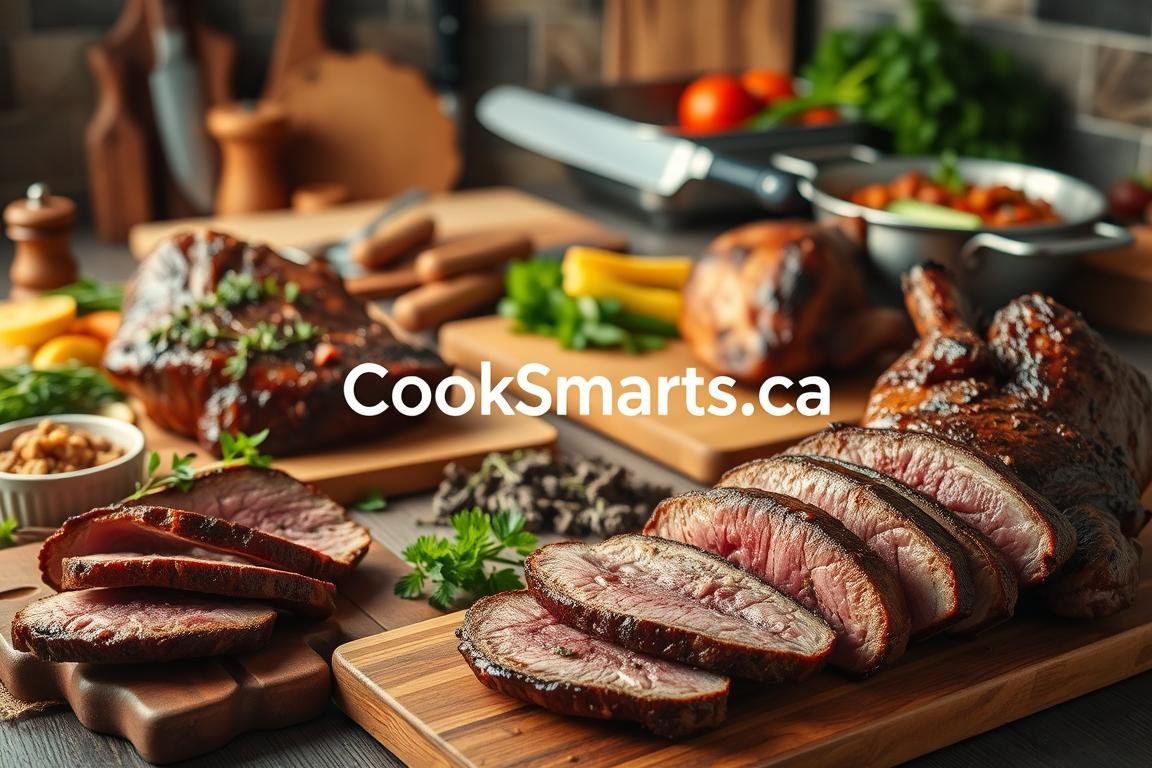
Imagine slicing into a juicy roast. You savor the tantalizing aroma before the tender beef melts in your mouth. It’s what food dreams are made of. And what if you could make this a reality in your home? This guide will show you the best way to roast meat. You’ll learn the secrets to choosing the right cut and seasoning. This is how chefs make meat both juicy and tender.
Roasting is more than following a recipe. It’s about preparation and knowing the meat. Why do chefs love a cast iron skillet for that perfect crust? Or how does oven roasting keep meat juicy and full of flavor? Your journey to the perfect roast starts now. This guide gives you the confidence of a chef.
Key Takeaways
- Learn essential techniques for creating a juicy roast that rivals high-end steakhouses.
- Understand how to select and prepare tender beef for optimal flavor and texture.
- Gain insights into chef-approved equipment that’ll elevate your roasting game.
- Grasp the pivotal concepts of temperature control and why it’s critical for the best roasting outcome.
- Discover marinades, seasonings, and the pivotal rest period that transform good meat into great.
- Unveil the curated wisdom consolidated in this comprehensive chef’s guide to roasting.
Understanding the Basics of Roasting Meat
Starting your roasting journey means getting to know meat roasting techniques and finding a solid oven roasting guide. It doesn’t matter if you’re a kitchen pro or cooking at home. Learning to roast can make your red meat cuts turn out tasty.
What is Roasting?
Roasting cooks meat with dry heat so it cooks all around evenly. This method is great because it makes the meat taste better and improves its texture. It’s perfect for big, lean cuts, and makes tough meat tender and delicious.
The Science Behind Roasting
Knowing how roasting works is key to doing it right. The heat breaks down fat and collagen in the meat. This brings out rich flavors and makes the meat tender. Always follow temperatures from 325 to 350 degrees Fahrenheit for big roasts. For smaller, tender cuts, go above 400 degrees. Letting the meat rest after roasting keeps it juicy.
Different Cuts of Meat for Roasting
Picking the right cut is very important for a roast. Beef top round, bottom round, or eye of round are great for roasting. These cuts are lean and perfect for slow roasting. Butcher Boy has tips on choosing cuts and recipes for dishes like boneless chuck roast.
To understand more about various meats and how to prepare them, check this table. It shows the best ways to handle different meats.
| Preparation Step | Temperature Range | Cut Examples | Key Tips |
|---|---|---|---|
| Initial Heating | 400°F+ | Beef Tenderloin, Pork Loin | Sear before slow roasting for enhanced flavor. |
| Main Roasting | 325 to 350°F | Beef Round, Leg of Lamb | Use a meat thermometer to monitor doneness. |
| Resting Period | N/A | All roasted meats | Rest meat for 15 mins to reabsorb juices. |
| Alternative Techniques | 275 to 325°F | Venison, Rosemary Pork | Slow roast after searing to retain moisture. |
Now that you know about meat roasting techniques, oven roasting guide, red meat cuts, and the basics of roasting foundation, you’re ready to make roasts that are as delicious as they look.
Preparing Meat for the Roast
Starting with careful meat preparation is key to a great roast. This includes choosing the best cut and the right seasonings. We’ll show you the essentials to get that perfect roast texture you’re after.
Choosing the Right Cut
Your choice of meat cut is very important. It depends on your desired texture and how you plan to cook it. For roast beef, top-round roast and eye of round are top picks. They cook evenly. Top-round is leaner, offering a tender texture, perfect for family dinners.
Marinating vs. Seasoning
Seasoning enhances the meat’s natural flavors. A mix of kosher salt and black pepper works well. It seasons the meat and helps form a tasty crust. Marinating means soaking the meat in herbs and oils for more flavor. Below is a herb rub mix ideal for marinating.
| Ingredient | Quantity | Purpose |
|---|---|---|
| Olive Oil | 1 Part | Base for marinade |
| Kosher Salt | 1 tsp per pound of beef | Seasoning & moisture extraction |
| Black Pepper | To taste | Flavor enhancement |
| Garlic, minced | 3 cloves | Flavor depth |
| Rosemary | 1 tbsp | Aromatic infusion |
| Thyme | 1 tbsp | Aromatic infusion |
Trimming and Tying Meat
Meat preparation is not just about seasoning. Trimming off excess fat and tying the roast are key steps. Trimming reduces smoke and flare-ups while roasting. Tying it up ensures even cooking and good shape.
By following these steps, your roast stays juicy and perfectly textured. At the end of your preparation, you’ll create not just a meal but a culinary masterpiece. Your efforts in preparing the roast will delight anyone at your table.
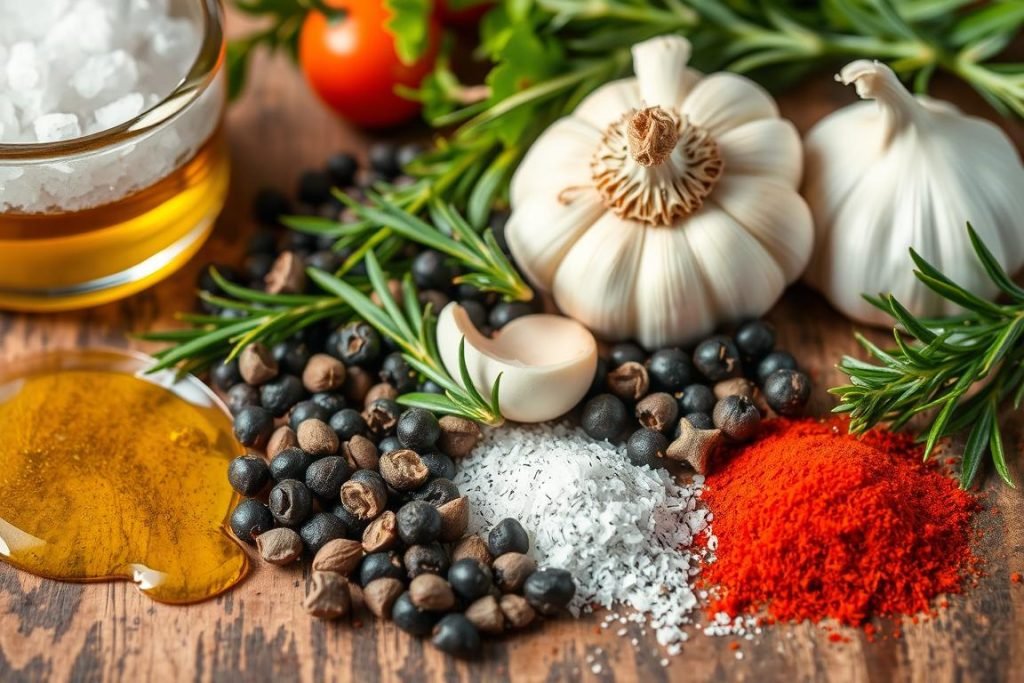
Essential Tools for the Perfect Roast
To make the perfect roast, you need more than skill. Getting the right roasting equipment is key for a tender dish. Let’s follow Molly Stevens’ expert advice to find the best tools.
Roasting Pans: What to Look For
A heavy-duty roasting pan is crucial. For big roasts, get a pan with high sides and tall handles. It keeps juices in and supports big cuts. A cast-iron skillet is also good, as it’s durable and great for browning meat.
Thermometers: Choosing the Best Type
A good meat thermometer stops you from under or overcooking. The Thermapen instant-read thermometer is perfect. It gives fast, accurate temperatures, making sure your meat is just right.
Carving Tools and Their Importance
After cooking, you need a great carving set for serving. Use a board with grooves for juices and a sharp, strong knife. Wooden boards are best as they are easier on your knives.
Here’s a quick guide to these must-have tools:
| Tool Type | Description | Recommended Brand/Type |
|---|---|---|
| Roasting Pan | Sturdy with handles, approx 3-inch sides | Cast-iron skillet, Heavy-duty rimmed baking sheet |
| Meat Thermometer | Thin-stemmed, instant-read | Thermapen |
| Carving Set | Board with juice grooves, sharp knife | Wooden boards with channels |
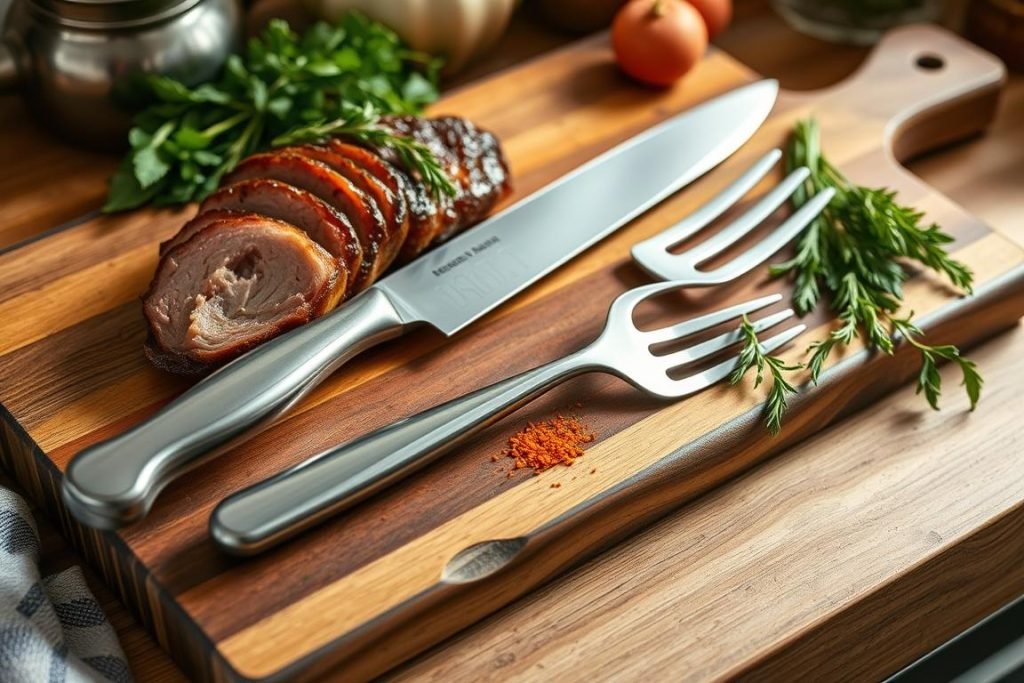
With these great tools, your roasting will improve. They ensure evenly cooked meat and perfectly cut servings. Equip yourself with the best to make every meal flavorful and well-made.
The Best Cooking Techniques for Roasting
Learning how to roast means you’ll get great meat every time. This part talks about the best roasting temperatures, why searing meat is good, and the need to let roasted meat rest. These are key to really knowing how to roast.
Convection vs. Conventional Ovens
Convection ovens are great for roasting. They move hot air around the food, cooking it evenly and quickly. Standard ovens might need you to turn the meat so it cooks right. Both are useful, depending on what you’re making and how.

Searing: To Sear or Not to Sear
Searing meat before you roast it makes it taste and feel better. This step browns the meat at a high temperature. It adds a rich flavor and helps keep the meat juicy.
The Importance of Resting
Letting your roasted meat rest is very important. It lets the juices spread out in the meat, making every piece tasty and juicy. The resting time depends on how big the meat is but it’s key for a great result.
These techniques improve your roast’s flavor and texture. They also show smart ways to cook meat right. Using these tips can make even a simple meal or a big dinner better. Knowing these methods will really improve your roasting skills.
Mastering Seasoning and Marinades
Learning the art of seasoning mastery is key to improving the taste and juiciness of your meats. Mastering these methods will make the meat’s natural flavors richer and the texture softer. This makes every bite deliciously juicy.
The Basics of Dry Rubs
Dry-brining requires knowing how much time and what amount of ingredients to use. Rubbing salt and herb and spice blends onto meat lets the flavors soak in deeply. This seasoning works from inside out.
Whether it’s beef, chicken, or pork, letting the rub sit from an hour to a day changes the meat’s texture and taste a lot.
Creating Flavorful Marinades
Marinades are great for adding complex flavors to meats. They mix acids like vinegar or lemon juice with fats and various seasonings. While using marinades, always keep the meat cold to stop bacteria from growing. Also, don’t reuse marinades as sauces.
Herbs and Spices That Shine
Trying different herb and spice blends can really make your dishes stand out. Mixing ingredients like rosemary, thyme, and smoked paprika creates unique flavors. These flavors make your meal memorable and make your roast exceptionally tasty.
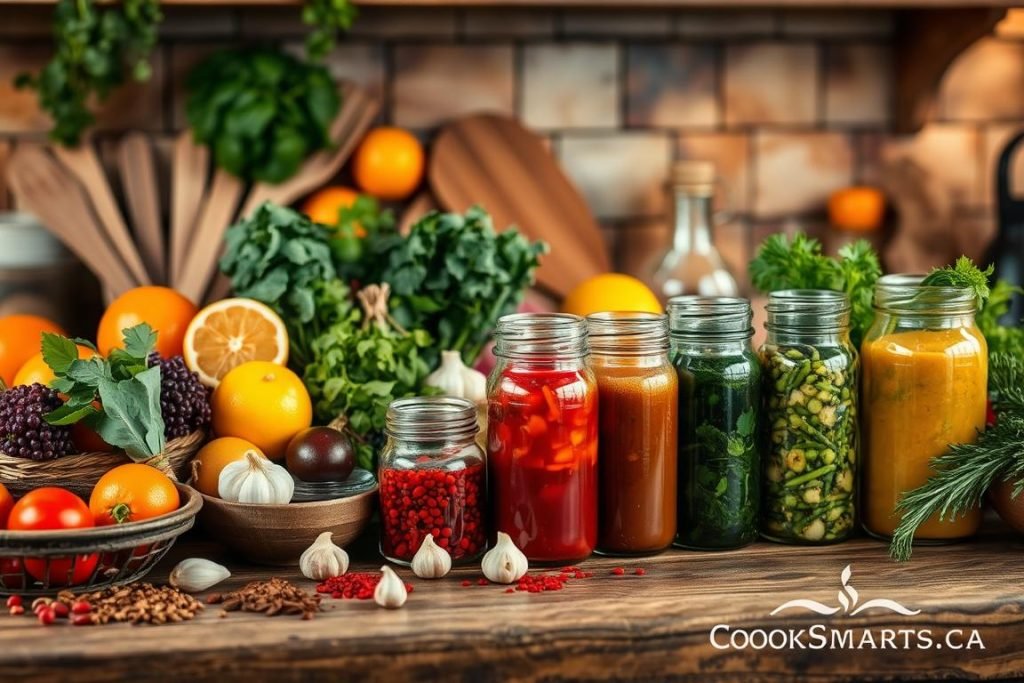
| Type of Marinade | Components | Recommended Marinating Time |
|---|---|---|
| Instant | Acid, Fat, Flavorings | Less than 30 minutes |
| Long-Term | Acid, Fat, Flavorings | Up to 24 hours for beef and lamb |
| Dry | Herbs, Salt, Spices | 1 to 24 hours |
| Cooked | Acid, Fat, Cooked flavorings | Varies depending on recipe |
By mastering marinades and dry rubs, you’ll make every grilled or roasted dish flavor-packed and tender. Explore marinade recipes and herb and spice blends to find your own kitchen flair.
Cooking Times and Temperatures
Exploring temperature precision and cooking times is crucial for great roasting. Mastering these can make your roasts juicy and cooked just right. We’ll cover key temperature tips, use handy roasting calculators, and share methods for consistent cooking.
Understanding Meat Temperature Guidelines
Knowing the right meat temperatures is key to perfect doneness. For juicy medium-rare beef, aim for 145ºF. A good meat doneness guide is essential for this.
How to Calculate Cooking Time
Roasting calculators help find the right cooking time, based on the meat’s weight and how you like it cooked. These tools give you a good estimate but check the temperature often for best results. Precision is key for delicious roasts.
Techniques for Consistent Results
To roast meat consistently, check its internal temperature regularly. This helps you get the same juicy results every time. Your oven’s unique traits and the meat’s specifics play a role here. Letting the roast rest after it’s out of the oven is also crucial for juicy meals.

Below is a handy table for roasting different meats, including optimal times and temperatures:
| Type of Meat | Weight | Oven Temp (F) | Cooking Time | Internal Temp (F) | Resting Time | Final Temp (F) |
|---|---|---|---|---|---|---|
| Beef Roast | 3-4 lbs | 325 | 1.5 – 2 hours | 135 | 15-20 mins | 145 (medium-rare) |
| Pork Roast | 2-5 lbs | 325 | 40-100 mins | 145 | 3 mins | 145 |
| Poultry | 3-4 lbs | 325 | 1.5 – 2 hours | 165 | None | 165 |
Using these guidelines and roasting time calculators makes sure your roast is always up to your standards. This is true for any occasion, from daily meals to special gatherings.
Common Mistakes When Roasting Meat
Roasting meat is more than cooking. It’s an art and a science. Yet, mistakes like overcooking, skipping rest times, mishandling seasonings, and not solving roast problems lessen meat quality. We will dive into these aspects to better your roast skills.
Overcooking: Signs and Prevention
Overcooked meat becomes dry and tough. Avoid this by checking the meat’s internal temperature with a thermometer, as chefs recommend. For example, cook shank cuts slowly to keep them moist and soft, countering high heat’s adverse effects.
Skipping the Resting Period
Don’t slice your roast right after it’s done. A rest period is crucial; it lets juices flow back, making the meat moist and tasty. Chef Douglas Keane advises resting the roast before cutting for the best juiciness.
Poor Seasoning Choices
Wrong seasoning makes roasts bland or too salty. For better seasoning, use kosher salt. Marinating or dry brining, as Chef Douglas Keane suggests, boosts flavor without hiding the meat’s natural taste.
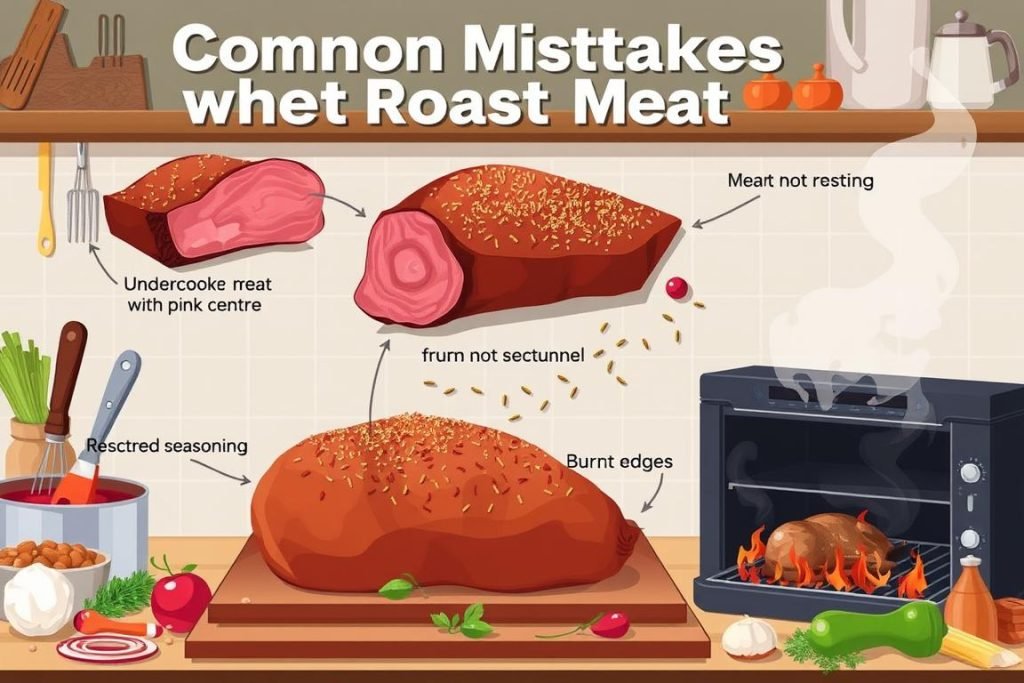
To season and cook perfectly, know each cut’s unique traits. For better results, don’t cover the roast while cooking. Covering can steam it instead of roasting. Here’s a look at different roasts and how to handle them:
| Cut | Description | Common Uses | Recommended Seasoning |
|---|---|---|---|
| Chuck roast | 20% fat, 80% meat ratio, robust flavor | Slow-roasted dishes, hamburger preparations | Dry rub, slow brine |
| Eye of round roast | Lean and tough, cut from a well-exercised muscle | Low and slow roasting | Herb rubs, thin marinades |
| Rib-Eye Roast | Tender, flavorful, well-marbled | High-heat roasting | Minimal seasoning, focus on external crust |
| Standing Rib Roast | Can contain three to seven ribs, juicy and tender | Special-occasion meals | Generous salt crust, aromatic herb butter |
| Sirloin tip roast | Flavorful but can be tough, from the hindquarters | Braising, stewing | Marinating, severe searing preceding slow cooking |
Choosing the right cuts and mastering the cook makes your meats savory and tender. Remember, every preparation and presentation step counts in roasting.
Pairing Sides and Sauces
Choosing the right sides and sauces makes roasted meat dishes unforgettable. Let’s dive into some perfect side dishes, a gravy recipe, and sauces. They make your roast harmonize in a special way.
Ideal Side Dishes for Roasted Meat
Vegetables are a hit with roast beef, with many sides focused on them. Mashed potatoes and potato wedges are favorites for their comforting taste. Sweet dishes, like sweet potatoes and maple-glazed carrots, bring a nice contrast.
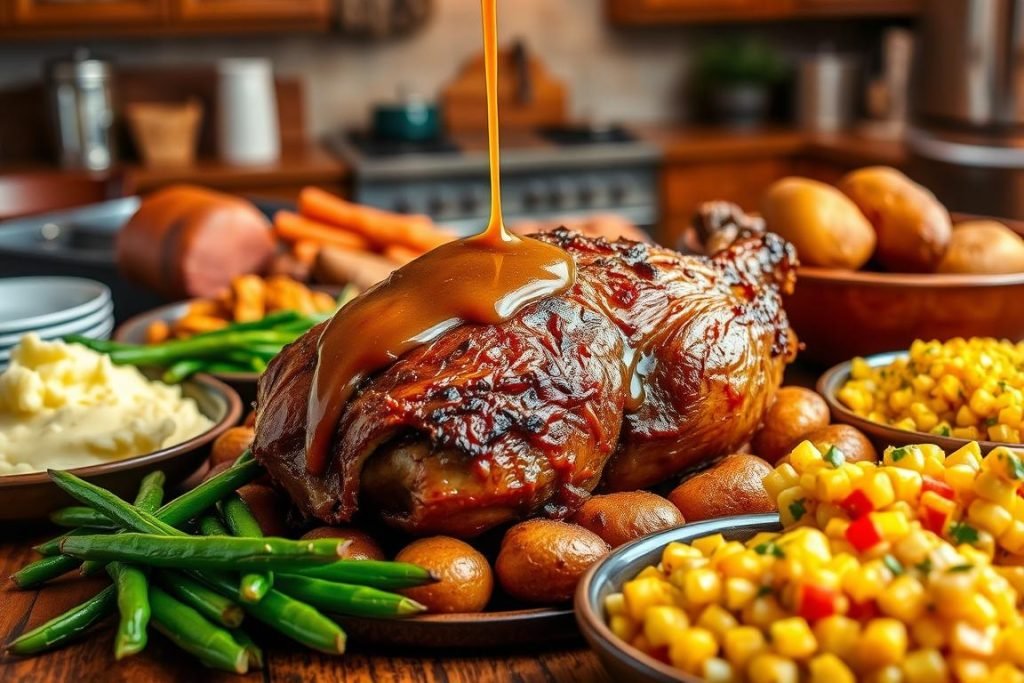
Making the Perfect Gravy
A great gravy comes from pan drippings, broth, or wine. It’s not just a topping but a key part of your meal. Adding fresh herbs and seasonings makes the flavor even better.
Complementary Sauces and Condiments
Try horseradish or strong mustard with your roast for an exciting taste. These sauces add new flavors and please different tastes, making every bite special.
| Side Dish | Calories | Fat (g) | Cholesterol (mg) | Sodium (mg) | Carbs (g) | Sugars (g) | Fiber (g) | Protein (g) |
|---|---|---|---|---|---|---|---|---|
| Butternut Squash Mac and Cheese | 422 | 13 | 36 | 750 | 60 | 10 | 12 | 20 |
| Homemade Breadsticks | 69 | 1 | 2 | 108 | 13 | 1 | 1 | 2 |
| Mashed Potatoes with Garlic-Olive Oil | 299 | 20 | 31 | 533 | 26 | 3 | 3 | 5 |
| Old-Fashioned Green Beans | 145 | 10 | 11 | 132 | 12 | 8 | 3 | 3 |
| Roasted Okra | 115 | 10 | 0 | 302 | 5 | 3 | 3 | 2 |
| Roasted Vegetable Medley | 109 | 7 | 3 | 96 | 10 | 3 | 3 | 4 |
| Potato Wedges with Sweet & Spicy Sauce | 218 | 9 | 1 | 449 | 31 | 12 | 3 | 2 |
Storing Leftover Roasted Meat
To keep your roasted meats delicious, you need to know how to store them right. Both seasoned chefs and home cooks should learn to keep leftovers safe and tasty. We’ll cover the best ways to store roasted meat, share leftover recipe ideas, and talk about freezing methods to make your meat last longer.
Best Practices for Refrigeration
Keeping your roasted meats cold is key to their quality and safety. Cooked meats like beef, turkey, and pork should be kept below 40°F. Make sure to refrigerate them within two hours of cooking to prevent bacteria growth. To keep things organized and safe, use airtight containers or wrap meats well in aluminum foil.
Here’s how long you can safely keep your roasts:
- Beef, Pork, Lamb: 3-4 days in the fridge
- Ground Meats: 1-2 days in the fridge
- Poultry: 3-4 days in the fridge
Creative Recipes for Leftovers
Turn your leftover roast meat into exciting new meals. Proper storage ensures your meals stay delicious the next day. For instance, use roast beef for sandwiches, salads, or tacos. Leftover meat is also great in stews or casseroles to bring back its flavor and texture.
Try these recipe ideas:
- Roast Beef Sandwiches with horseradish sauce
- Pulled Pork Tacos with fresh salsa
- Chicken Salad with grapes and nuts
Freezing Roasted Meat Safely
Freezing your roasted meats correctly keeps them safe and delicious for months. Prevent freezer burn by wrapping meat tightly in aluminum foil or using heavy-duty freezer bags. Below is a guide on how long to freeze meats and the best materials to use:
| Meat Type | Storage Time | Best Wrapping Material |
|---|---|---|
| Roast Beef | 2-6 months | Aluminum Foil |
| Roast Turkey | 2-6 months | Freezer Bags |
| Pulled Pork | 1-3 months | Vacuum Seal Bags |
For the best results, label your meats with the date before freezing. Split them into portions for easy use later. This step keeps the meat’s quality high and helps with meal planning.
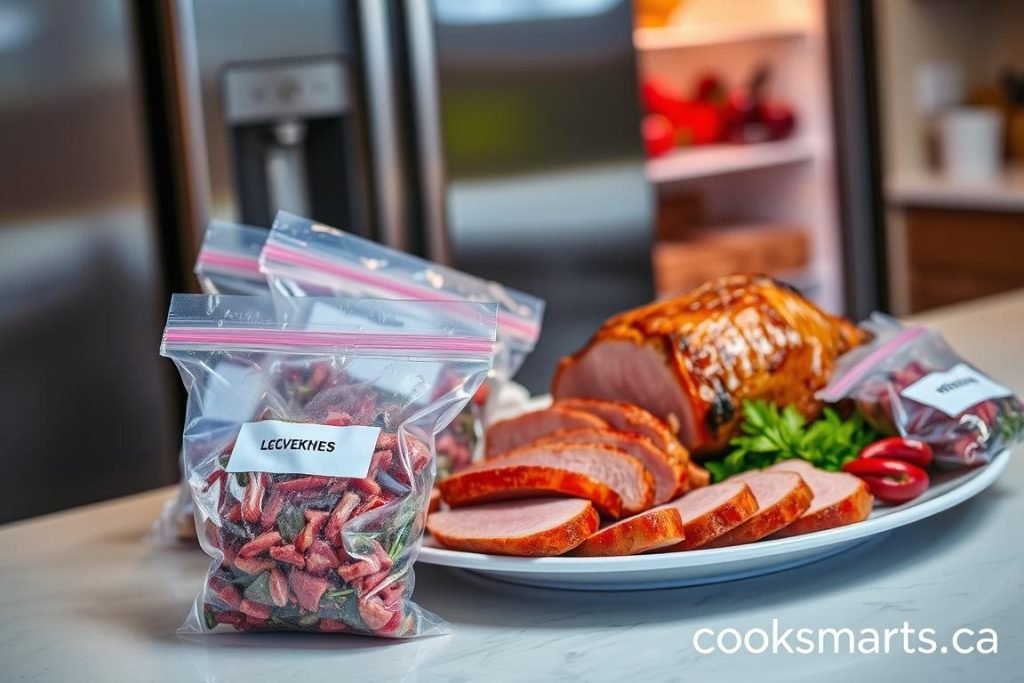
Tips from Professional Chefs
Want to get better at roasting? Learn from professional chefs. They share tips and secrets to make your roast tender and juicy. They cover everything from keeping the meat juicy to making it tender.
Insider Secrets to Juiciness
Chefs say to sear meats at high heat before slow roasting. This keeps the juices in, making every slice succulent. Adding onions, carrots, and celery boosts moisture.
Ensuring Tenderness Every Time
To keep a roast tender, don’t overcook it. Let it rest after cooking. Pick the right cut and cook it just right. Roast it at 300-325 degrees Fahrenheit and let it rest before cutting.
Creative Roasting Techniques to Try
New roasting methods can turn a meal gourmet. Pan roasting brings out rich flavors. Use a cast iron pan to sear the meat on all sides. Then put it in the oven. It cooks faster and simplifies things, making it popular among chefs.
| Cooking Method | Description | Temperature | Time |
|---|---|---|---|
| Pan Roasting | Combines searing and oven roasting for enhanced flavor and juiciness. | 300-325°F | 20 mins |
| Standard Oven Roasting | Uses dry heat to cook the meat evenly, suitable for larger cuts. | 400-450°F | Varies by weight |
Use these chef’s tips next time you roast. You’ll see a big difference in taste and texture. These tips make any meal, from holiday feasts to simple dinners, more enjoyable.
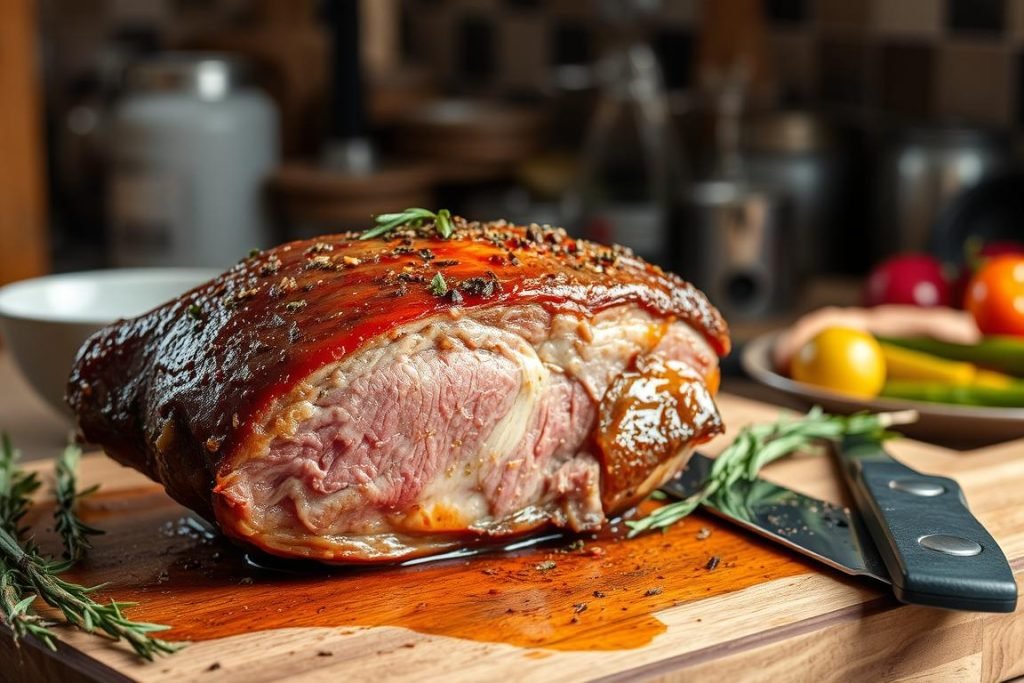
Conclusion: Your Roasting Journey Awaits
As you learn the art of roasting, you grow as a culinary expert. Each step, from choosing the right meat to perfecting your seasonings, matters. You’ve gained the tools and knowledge to roast with confidence.
Remember to marinade, control cooking temperatures, and rest your meat. These steps will ensure delicious results every time.
Recap of Key Points
You now know about tools like Charcoal Grills and Gas Grills. And accessories like Long-Handled Tongs make roasting better. We’ve shared secrets, like using a Sweet & Spicy Glaze, for a great meal.
You’ve learned recipes from Smoked Pulled Pork to Grilled Seafood. There are also plant-based options like Tofu steaks. Your menu will surely wow your guests.
Encouraging Exploration and Experimentation
Explore with different meats, like Pekin or Moulard duck. Adjust your methods to suit each unique type. Experiment with rubs, marinades, and glazes to enhance your dishes.
Master the art of timing. Knowing when to flip your meat can make a big difference in your feast.
Inviting Feedback from Readers
We love hearing from you. Share your successes, creative ideas, and even your mistakes. Your stories contribute to our community’s knowledge.
With your help, we’ve grown a rich culinary community since 2009. Your insights add to a story of joy, roasting, and sharing good food.